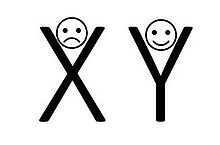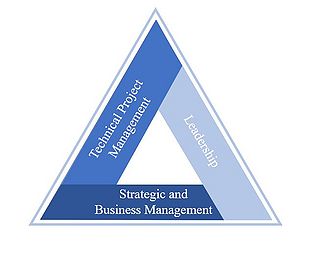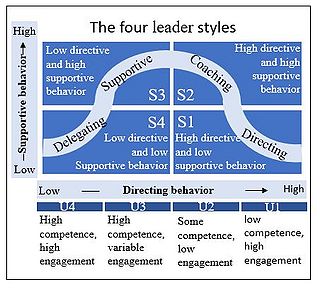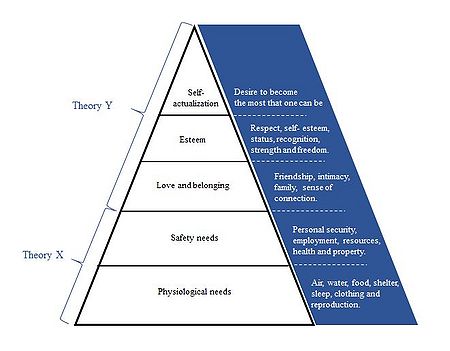McGregor's X & Y theory

Douglas McGregor was a professor at Massachusetts Institute of Technology and developed in the 1960’s the two motivation theories X & Y, alongside the work of the American Psychologist Abraham Maslow. The theories described the two different manager styles, and how the project manager's primary beliefs has a big influence on how the employees are motivated and how the organizations are managed. [2] Finding how the employees are motivated, is intriguing because a motivated co- worker is more likely to help the manager achieve the project objectives.
Theory X is based on the opinion that the employees does not want to work and must be externally motivated. The X illustrates the employee crossing arms in front of him/her and symbolizes “I do not want to work”.The alternative approach is theory Y which are more recognizable in todays manager style. Here the manager believes the employees are motivated internally by work satisfaction and are encouraged without direct supervision. The Y describes an employee with open arms. “I am happy to work.” [1]
These theories are not particular used in practice, but are however an interesting way of viewing the two different aspects of project management and employee motivation. The motivation topic is time accurate because of the continues aiming for self- actualization. To understand how a project manager can use motivation as a tool, it is essential to consider what it is that motivates, and which factors that influence motivation such as relationships and the managers soft skills.
Contents |
Motivation
Motivation and Human Relation Movement
There are several different tools and theories that point out the importance of the human aspect in project management. The ability to motivate and the relationship between employees, teams and individuals are some of the regulars.
The importance of motivation related to work, started with the human relation movement. Motivation, social relation, and employee satisfaction was investigated in relation to factory productivity in the 1930s’. Here the workers were considered in terms of their psychology rather than as replaceable bricks. The movement realized that organizational structures and processes influenced worker behavior and motivation.[3] Elton Mayo, which was one of those who laid the foundation of this movement, was especially interested in group effects on the behavior of individuals at work. He stressed the power of natural groups, two-way communication, and high-quality leadership.[4]
Some of the most interesting theories that developed after the human relation movement, was the Maslow's hierarchy of needs and McGregors theory X and Y. These are one of the most known motivation theories and it is said to be the foundation for organizational studies and organizational communication studies.[5]
What motivates
In extend of the Human relation movement the Maslow hierarchy of needs was presented, which laid the foundation for every human being and the universal needs of society. Humans have several needs, which follow the step of the pyramid where the basic needs at the bottom must be satisfied in some extent to be able to climb upwards. They are not fixed, but they are basic needs which influence the human mentality and our tendency for growth, identity, and excellence. For individuals to complete their hierarchy, a portion of internal sensation must be met. The five steps that human motivation generally need according to Maslow are: physiological, safety, belonging and love, social needs, esteem, and self- actualization.[6] [7] These applies for theory X and Y and are shown in figure 2.
Theory X
Theory X is based upon that the manager tends to think that the workers are naturally unmotivated, avoids reasonability, must be controlled, needs supervision in every step, have no work ambition and do not like employment. To be sure the workers complete their task, the manager often motivates with money or penalties, also referred to as the carrot-to-stick approach. To control staff performance, tangible results are used. An example of this is sales figures. Usually this type of managing has an authoritarian style and a top- down approach. In this case the managers tend to micromanage people's work, which is often seen in process-driven workplaces. These types of workplaces are often huge organizations with a big number of employees and tight deadlines. [9] [1] [10]
Theory Y
Theory Y describes the managers to have a positive opinion of their employees, which encourage to a more trust-based relationship. This means that the employees get more responsibility and are encouraged to a more open communication. The workers are assumed to be happy to work on their own initiative, to take ownership of their own work and requires less direction. In addition, they tend to approach the work as fulfilling and challenging, and solves problems creatively and imaginary. The workers are individualized and are going towards a higher level of self-actualization, which is also referred to in the Maslow hierarchy of needs. [11] [9]
Related to The hierarchy of needs
The Maslow hierarchy of needs describes how effort and motivation are correlated. The hierarchy can therefore be linked to the two theories, X and Y. Theory X describes motivation relative to the employees needs of financially safety. This need is one of the basic needs, and therefore the most effective incentive to make people work as it demands less interpersonal effort. This relates to the two basic needs at the bottom of the pyramide, safety- and physiological needs, where the factors food, shelter, job and insurance among others are key essentials.[6] For obvious reasons, these needs will always be important for the employees. This means that the employer will not give you as a project manager or an employee, any other reason to keep on working in that specific firm, other than money.
Whereas esteem, self- actualization and love and belonging are essential motivation tools in theory Y, where the project manager use these to drive their employees to achieve success, the more basic needs of physiological and safety needs are the only needs related to theory X. Working with theory Y will therefore demand a greater amount of effort. When managers follow the theory Y in a greater extent, it will create positive ripple effects on the associated team, group, and organization. [6] [8]
Interpersonal relationship
Before McGregor's theory was published, those who wrote about leadership focused on the qualities and characteristics of 'Great People'. This was to identify the individual qualities of great leaders. McGregor argued that alongside individual qualities, there was also complex relationships to manage in order to succeed as a leader. "He was one of the first to argue that leadership was more about the relationship between the leader and the situation they faced, than merely the characteristics of the leader alone."[2] Therefore it is interesting to investigate relationship in form of interpersonal relationship related to work.
To be able to accomplish the need for belonging, love, acceptance, and social exchange relative to the three steps at the top of Maslow's pyramide, relationships are important. According to the Book, Interpersonal Relationships by Diana Jackson- Dwyer, Foundation of psychology, establishing and maintaining relationships is essential in order to accomplish motivation: "..humans have evolved a need to belong, which is a fundamental motivation." [12]
The concept of interpersonal relations, also called relationship science, demonstrates why relationships are meaningful. Interpersonal skills are useful to communicate and create a reliable relationship and personal growth. By using soft skill or development of interpersonal communication, it is possible to exchange feelings with the use of verbal or non- verbal messages. This competence leads to preferable qualities such as effective and good communication, decision-making, problem solving, optimism and teamwork. [13]
There are several types of relationships that involves social associations, connections, or affiliations between two or more people. One of them are business relationship and relates to partnership, employer/ employee, contractors, costumers, and coworkers. These relationships are dynamic systems and continuously vary from start to end. Business relationships are to some extent different, and may include power and dominance. A dominant relationship is when the relation has an unequal distribution of power, where one is dominant and the other are submissive. Dominant people can influence the behavior of others. Often, submissive people will follow given instructions without disagreement, or disagree at first and then follow instruction when pressed. This type of relations is often seen in hierarchical organizations and correlates with uneven distribution of power.[13] If applied to McGregor's theory, this kind of relationships can be found in workplaces where the managers uses the Theory x in a greater extent.
Top- down management is an example of hierarchical organization where a group of people form a dominant hierarchy. In this case, submissive people will be beneficial because they cause less discussion and disagreement. This may save time, prevent inconsistent decisions, maintain the owner’s organization goals, and use those who have the most power to make important decisions. This can be beneficial in terms of organizational and decision-making efficiency, but the organization will not experience democracy and may leave out qualified workers with expertise on the field.[13]
According to the German- born psychologist George Levinger, the natural relationships follows five stages; Acquaintance and acquaintanceship, buildup, continuation, deterioration, and ending. The five stages describe all types of relationships and can provide a valuable understanding of how a relationships occurs. [13]
1. The first step is based on the first impression and may lead to the next stage, if the two parts like each other or are an acquaintance or establish acquaintanceship.
2. At this stage the buildup of trust and care for each other is a key- point whether or not the interaction continues.
3. This phase is about mutual commitment and continuation of a long- term friendship in form of growth and trust.
4. If the communication and self-disclosure are absent at this stage, the relationship tend to deteriorate.
5. Without resolving problems or reestablishing trust, ending would be the final stage. [13]
In relation to Project management
The motivation theory applies for both management and leadership, although management have a tendency to direct people from one way to another by using the skill of expected behavior. A leader on the other hand, would rather use discussions to guide. To be successful as a project manager, balancing both skills in different situations is needed. A project managers task is to achieve a project’s objectives by leading a project team. The role of a project manager may vary from project to project, and organization to organization, but includes the communication role between team members, stakeholders, and project sponsors. [14]
According to the British Standard: Managing successful Projects with Prince2, project management is "the planning, delegating, monotoring and control of all aspects of the projects, and the motivation of those involved, to achieve the project objectives within the performance targets.. " [15] To do this it is important to be able to manage people. This can be done using soft skills, such as interpersonal competence. This type of proficiency can be used as a tool to avoid or solve conflicts and to achieve consensus with the project stakeholders. [14]
What is a successful project manager?

To be the most effective project manager, recent PMI (Project Management Institute) studies have shown that the skills needed are the combined competences seen in the PMI Talent triangle. Here it is not only the technical, strategic, or business aspects of management competence that are important, but also the knowledge and ability to guide, motivate and direct a team to achieve the project objectives. This type of competence is also seen in qualified leaders. [14]
A reoccurring theme in every project is people. Dealing with people is not as elementary as dealing with logistics, numbers, graphs or programs. Therefore, the knowledge of peoples behavior is essential to be able to motivate and guide. To accomplish success, a project manager should have these abilities and strive to be a greater leader. This type of expertise also applies when working with project stakeholders, the project team and sponsors. Qualities and competences for a good project manager are managing relationships and conflicts by building trust, seeking consensus, being respectful, ethical, service minded, a problem solver and use this to build effective teams. [14]
Marcus Buckingham wrote in March 2005 the article “What Great Managers Do”, in the Harvard Business review magazine after researching managers in general and its top performers. He found out that there is one quality that separates great managers from the rest: “They discover what is unique about each person and then capitalize on it. Average managers play checkers, while great managers play chess.” The difference was that top performing managers treated the employees with the knowledge of each unique value and their abilities, rather than in checkers where the pieces moves at the same pace on parallel paths. It is a plan and a coordination behind every movement, but each employee is treated the exact same way. Top performing managers discover peoples uniqueness and likes to work with people. «Fine shadings of personality, though they may be invisible to some and frustrating to others, are crystal clear to and highly valued by great managers.” [16] With all of this in mind, one could therefore argue for that McGregor's theory Y is highly applicable in order to achieve this kind of leadership.
Application

According to reinforcement theories, humans behave in a specific way because it can be rewarding to them.[12] When a project manager has the skills and ability to motivate employees, the managers own goals are more likely to be fulfilled. This means that both parts are rewarded.
To understand what motivates people, it is important to understand what makes a person work towards a particular goal or result with a high level of commitment. This is because motivated employees are more productive and therefore more profitable.[16] Managers can therefore use McGregor's theory as a tool to understand the importance of motivation, and is therefore highly interesting in a project managers perspective. Based on these two theories, the assumptions made about the team members or employees can have an influence on how they are managed. Based on evaluated circumstances, a project manager can also choose the most preferable method to fit the project by investigating the employees and work environment.
An example of a model that motivates after evaluating each individual, is The Situation Based Leadership model. The Situational Leadership model also called The Hersey- Blanchard Model, developed by Paul Hersey and Kenneth Blanchard, is a tool "that focuses on the ability and willingness of individual employees" [18] This model helps the leader to motivate the employee based on their capacity and experience. The model uses a diagram to classify the employees in four different categories and four belonging leader styles that adapt leaderships methods corresponding to a specific level of employee development. The model focus on the individual, and can therefore be challenging to apply on groups with variation of experience and abilities.[18]
To be able to fulfill the project objectives a different way of using the theory X and Y is to create an optimal project team by handpicking the most suitable persons. Companies uses resources and effort into hiring people that fits the company by a thorough recruitment processes. There are several methods used to find the right candidates. Personality tests such as the Big five or ability tests like Korn Ferry are commonly used. This is to create a well functioning team that meets the companies preferable qualifications and standards to achieve successful projects.
Limitations
Douglas McGregor was a professor at Massachusetts Institute of Technology, where he was a vocal advocate of the human relations approach. He studied heavily how our beliefs shape our behavior and thus how that behavior shapes the behavior of those around us. [19] Therefore it it reasonable to believe that he was more engaged in theory Y, which might explain why there is such a big contrast between the two theories. One can also assume that organizations and the work culture has changed over the past years, and that there is not that easy to divide the two manager styles and employee behavior, as it was done at the time when theory X and Y was developed.
Theory X and Y are two extremes on the scale, and are not necessarily the case for a specific situation. A combination of the two theories are often used rather than picking one over the other. The military is often associated with theory X. A particular reason for this is how the military works as a hierarchy, where the commanders rank indicates the degree of power over the soldiers. They are the one who are taking the decisions. The exact purpose of this is to obtain control and command by using highly constrained patterns with limited information. The strict rules have changed a bit, and a more modern way of doing this is the possibility of individual initiative. This can be in the form of individual judgement and action, within defined constraints. Mission command is an example of this, and this management concept are often used in modern military. This actively demonstrates that combining the two theories can be beneficial.[1] In relation to this, there are also different types and scales of projects, which makes it irrational to apply one theory over the other for all projects. In addition, McGregor based his theories on Maslow hierarchy of needs, which is not based on scientific proofs but rather "observations of humans' innate curiosity" [6] One can therefore argue that the human needs discovered by Maslow is not entirely accurate for all human beings.
Annotated Bibliography
PMI standards
Guide to the Project Management Body of Knowledge 6th edition, by Project Management Institute, Inc 2017.
This book proves "detail about key concepts, emerging trends, considerations for tailoring the project management processes, and information on how tools and techniques are applied to projects. Project managers may use one or more methodologies to implement the project management processes outlined in the standard" The book is limited to project management do not include program-, and portfolio management.
British standards
Managing successful Projects with Prince2 2017 edition, Published by TSO.
This book is made as a guidance to the use of the leading project management method PRINCE2. PRINCE stands for PRojects IN Controlled Environments, it is a well known method and widely used in the world. The method is established by experience from thousands of projects and countless project sponsors, project managers, - teams, academics, trainers and consultants. First edition of the book was made in 1996, this is the sixed edition from 2017.
Readings in Managerial Psychology
Readings in Managerial Psychology, Third edition from 1960, The Human Side Of Enterprise, Douglas M. McGregor, Edit by Harold J. Leavitt, Louis R. Pondy, and Davis M. Boje
Douglas M. McGregor's original description of Theory X and Y from The Human Side of Enterprise. The work has been stated at the moment over 17 000 times on Google Scholar.
References
- ↑ 1.0 1.1 1.2 1.3 www.wikipedia.org, Theory X and Theory Y[1]
- ↑ 2.0 2.1 Journal Article , Douglas McGregor - a lasting impression, Robert A Cunningham, Ivey Business Journal, Sep/Oct vol 75 issue 5, 2011 [2]
- ↑ www.wikipedia.org, Human relations movement[3]
- ↑ www.wikipedia.org, Elton Mayo[4]
- ↑ 5.0 5.1 www.youtube.com, Theory X and Y, Organizational communication Channel[5]
- ↑ 6.0 6.1 6.2 6.3 www.wikipedia.org, Maslow's hierarchy of needs[6]
- ↑ Simplply Psychology, Maslow's Hierarchy of Needs by Saul McLeod, May 21, 2018.[7]
- ↑ 8.0 8.1 www.simplypsychology.org, Maslow [8]
- ↑ 9.0 9.1 www.mindtools.org, Theory X and Theory Y Understanding People's Motivations[9]
- ↑ Readings in Managerial Psychology, Third edition from 1960, The Human Side Of Enterprise, Douglas M. McGregor, Edit by Harold J. Leavitt, Louis R. Pondy, and Davis M. Boje.[10]
- ↑ www.hbr.org, Harvard Business Review, Beyond Theory Y by John J. Morse and Jay W. Lorsch, 1970 05[11]
- ↑ 12.0 12.1 Interpersonal Relationships by Diana Jackson- Dwyer, Foundation of psychology [12]
- ↑ 13.0 13.1 13.2 13.3 13.4 www.wikipedia.org, Interpersonal relationship [13]
- ↑ 14.0 14.1 14.2 14.3 14.4 PMI standard, Guide to the Project Management Body of Knowledge 6th edition, by Project Management Institute, Inc 2017
- ↑ British standard, Managing successful Projects with Prince2 2017 edition, Published by TSO
- ↑ 16.0 16.1 www.hbr.org, Marcus Buckingham, What Great Managers Do, Harvard Business review magazine, march 2005 [14]
- ↑ Mid- american Journal of Business, Volume 12, number 2, Fall 1997, Situational Leadership by John R. Schermerhorn,Jr.[15]
- ↑ 18.0 18.1 18.2 www.corporatefinanceinsitute.com, What is the Harsey- Blanchard Model?[16]
- ↑ www.lucischart.com, Theory x vs theory y by Lucidchart Content Team [17]
